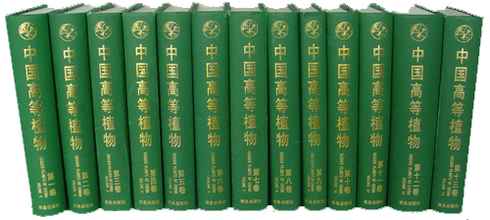The great work on plant taxonomy-Higher Plants of China, which consists of 14 volumes, has been totally published at the end of 2012. Prof. Liguo Fu from Institute of Botany, CAS is the editor in chief.
The knowledge of plant taxonomy built the foundation for protecting biodiversity as well as the development and utilization of plant resources. The publishment of Higher Plants of China meets the need of researchers covering areas such as forestry, agriculture, animal husbandry, traditional Chinese medicine, environmental protection, botany research, education and so on。
The compilation of Higher Plants of China was initiated by Chinese Academy of Sciences since 1997. Shenzhen Fairy Lake Botanical Garden, Qingdao Publishing House, Department of Wildlife Conservation and Nature Reserve Management, SFA also contributed a lot to the book.The book absorbs the essence of three other great plant books: Iconographia Cormophytorum Sinicorum, Flora Reipublicae Popularis Sinicae and Flora of China. It contains the common species in forests, vegetation and gardens, species that has economic or research value, species that are found in two provinces and above, species that are widely distributed in adjacent countries but only in vicinity provinces of our country, representative species of each genus and common foreign species that is for introduction cultivation.
The book has 30 million characters, with color photos attached for 3646 species. A retrieval table is also attached for each family and genus. Totally there are 532 families, 3957 genera, and 20713 species (including infraspecific taxon) of higher plants in China are recorded in the book, and a standard Chinese name, Latin name with reference are marked for each species. In the book, each species is presented with a brief description of morphology, distribution, habitat, phenology, and the main use for some species is also included. What’s more, each plant species is accompanied (except for exotic species) with a distribution map to the county level.
In total 86 units, 197 writing specialists, 205 drawing personnel, 161 photographers are participated in the editing of this book. To some extent, the book represents Chinese botanists’ wisdom and cooperation.

Higher Plants of China
The great work on plant taxonomy-Higher Plants of China, which consists of 14 volumes, has been totally published at the end of 2012. Prof. Liguo Fu from Institute of Botany, CAS is the editor in chief.
The knowledge of plant taxonomy built the foundation for protecting biodiversity as well as the development and utilization of plant resources. The publishment of Higher Plants of China meets the need of researchers covering areas such as forestry, agriculture, animal husbandry, traditional Chinese medicine, environmental protection, botany research, education and so on。
The compilation of Higher Plants of China was initiated by Chinese Academy of Sciences since 1997. Shenzhen Fairy Lake Botanical Garden, Qingdao Publishing House, Department of Wildlife Conservation and Nature Reserve Management, SFA also contributed a lot to the book.The book absorbs the essence of three other great plant books: Iconographia Cormophytorum Sinicorum, Flora Reipublicae Popularis Sinicae and Flora of China. It contains the common species in forests, vegetation and gardens, species that has economic or research value, species that are found in two provinces and above, species that are widely distributed in adjacent countries but only in vicinity provinces of our country, representative species of each genus and common foreign species that is for introduction cultivation.
The book has 30 million characters, with color photos attached for 3646 species. A retrieval table is also attached for each family and genus. Totally there are 532 families, 3957 genera, and 20713 species (including infraspecific taxon) of higher plants in China are recorded in the book, and a standard Chinese name, Latin name with reference are marked for each species. In the book, each species is presented with a brief description of morphology, distribution, habitat, phenology, and the main use for some species is also included. What’s more, each plant species is accompanied (except for exotic species) with a distribution map to the county level.
In total 86 units, 197 writing specialists, 205 drawing personnel, 161 photographers are participated in the editing of this book. To some extent, the book represents Chinese botanists’ wisdom and cooperation.
 |
| Higher Plants of China |
